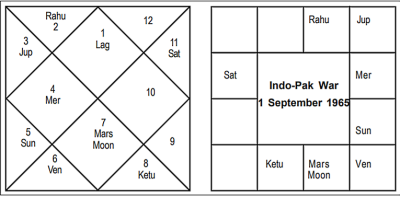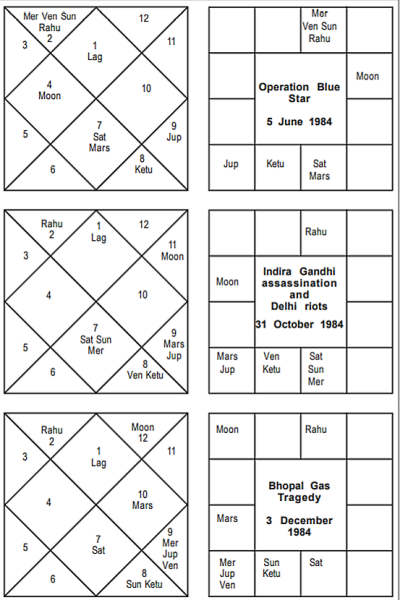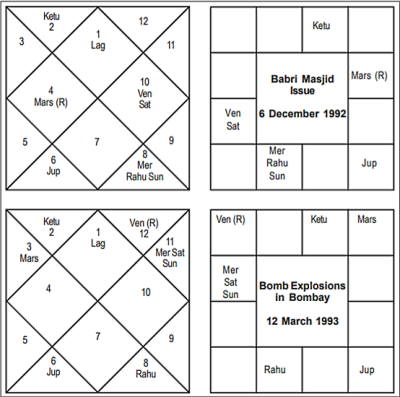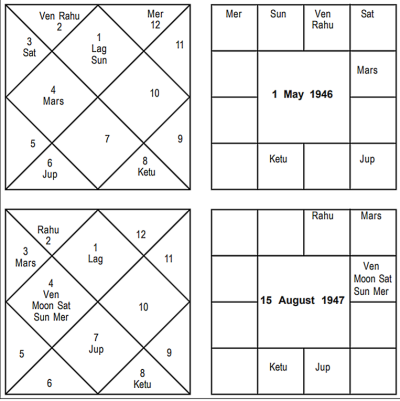To explain this research the lagna adopted in all cases is Vrisha (Taurus) which is the lagna of the Indian Independence horoscope. The event referred to may have taken place when different lagnas must have been rising. This will help understand this paper. Besides, when Vrisha is referred to, it must also be kept in the mind that the most important nakshatra or constellation here is Rohini which covers 13020 degrees from 100 00' to 230 20' which has been referred to as Rohini bhedana or the ingress of Saturn into this area. But, in the present research, the principle of Rohini bhedana has been extended to a briefer period of Rahu's transit in this area. Yet, if the entire Vrisha is taken, the research will be understood with more clarity, because before entering Rohini there is the shadow of the coming event while after crossing it, the aftermath of the havoc wrought by Rahu in Rohini.
It is a sad commentary on the slavish mental attitude of most of the Indologists that they have paid very little attention to astrology and astronomical references to religious, classics and scriptures of this country and have followed the British tradition of approach which has resulted in mistiming and distorting major landmarks of Indian history. As a result the glorious heritage of Hindu civilization has not been sufficiently highlighted.
It is a pity that 50 years have elapsed since we got our Independence and as yet no serious efforts have been made to rectify the distortions and misrepresentations conceived in sheer ignorance and mischief earlier. The classical astrological and astronomical references have been dismissed as sheer figments of imagination and our whole spiritual base of the great civilization has been eroded and shifted to the backstage.
It goes to the credit of persons like K N Rao to dig up the past and with modern researches to prove that one of our greatest heritage was the science of Astrology which drew its sustenance from the spiritual base which was the part of "Glory that was India".
A reference is invited to Rao's article 'Prism of a Prediction' published in September October 1984 issue of Astrological Magazine in which it has been stated that entry of Saturn in Rohini Nakshatra has meant involvement of War for India.
Taking a cue from this article and under guidance of Mr. Rao, following paper has been produced which has been divided into three parts. 1. War starts when Saturn is in Taurus in Rohini Nakshatra {World War I, August 1914, Quit India movement and revolt of 1942 (August, September) revolt in East Bengal and Exodus of Hindus during Indo-Pakistan War, 1971} 2. Rahu/Ketu axis in Rohini (Taurus/Scorpio) 3. Double affliction - Saturn and Rahu/Ketu both in Rohini/Taurus (Year 2003)
Scriptural Background
In the Uttarkhand Section of Paddam Purana there is reference to the explanation given by lord Shiva to Rishi Narad about role of Saturn, both in mundane as well as individual horoscopes. Saturn had reached the end of Krittika Nakshatra (10 degrees in Taurus) about to enter Rohini. King Dashratha was warned that this would lead to a terrible famine and also a war.
It is also stated there that when King Dashratha reaches Saturn's world (Shani-Yug), he is greeted by lord Saturn and is told that as a result of his Saturnine side any one would be destroyed.
Somehow, Dashratha was saved. Saturn was happy with Lord Dashratha and wanted him to ask for a boon. Dashratha requested Lord Saturn to save the world from agony of wars and famine. Thereafter, Dashratha recited the famous 'Neel Shani Stotra' (in which a classic reference is made to Saturn immersed in yoga practices and having totally emaciated body).
Saturn then assured Lord Dashratha that while in transit if he is in Lagna, the 4th house or the 8th house, he would cause agony to anyone excepting to those who worship him sincerely through this Stotra.
The question now arises whether the above is a story, a myth or is there some truth in it?
Let us go back in history and see the role of Saturn in Rohini.
1. Saturn was in Rohini in November, 1913 to May, 1914. This was the time when events leading to World War I took place. Gandhiji also started Satyagraha Movement in South Africa. 1942 June to end of 1942 - Quit India Resolution and Revolt of 1942. 1971 (July, 22 to November, 17) Revolt in East Bengal and events leading to IndoPak War.
2. Rahu/Ketu axis in Rohini/Taurus - Events are described in details in paper attached.
3. Double affliction/Triple affliction . In the Mahabharata - in the Udyog Parva Chapter I 43, Shalokas 8, 9, 10 Karna tells Krishna as to why Kauravas on whose side he was fighting would in any case be defeated. Incidentally explanation given by Karna is purely astrological and reference is made to three conditions.
a) Saturn afflicting Prajapati, (Parjapati meaning Lord Brahma identified with Rohini in Taurus).
b) Second reason given was that Mars retrograding in Jyeshta (Scorpio) was entering Anuradha, which was a sure indication for fall and destruction of kings in power along with his friends.
Note : Mars stays in a Rasi for about five months and during such period it has repeated direct and retrograde motions. It is a well known principle of astrology that wars are caused when Saturn/Mars/ Rahu are in quadrants from each other and when Mars retrogrades; for instance in 1971 Mars retrograded on July 10 in Capricorn where it stayed long for six months. This was the time when Indo-Pak war had erupted. Similarly in 1960-61 Mars stayed long in Gemini. It became retrograde on November, 20 (in Gemini from September, 1960 to April 1961), and it was on 20 October, 1961 that Indochina war broke out. Saturn and Ketu were exactly 10 degree in Capricorn while Mars/Rahu were 10o in Cancer.
c) The third principle astrologically refers to entry of Ketu in Chitra in Tula and Kanya which was again indicative of destruction of the Kings in power.
Thus an effort has been made to prove that reference in our ancient and holy scripture should not be taken lightly of, for here lies the key to the understanding of the future and scholars and saintly figures like Mr. Rao are trying to delve deep into our sacred past for digging up words of deep wisdom which may unravel mysteries of the past and lead us to a brighter future of tomorrow.
Rahu/Ketu axis in Rohini/Taurus Years of Famine and Drought (1898-1900)
These were the years of drought and famine in all parts of India. The famine of 1899-1900 affected an area of 1,89,000 sq. miles and a population of 28 million. There was total break down of civil authority. Whenever famine relief operations were under taken, there was a sea flood of humanity overtaking it. There was hunger and death every where and such misery prevailed as was not seen before. Closing years of the nineteenth century witnessed also the horrors of bubonic plague, which in addition to famine added miseries to the people.
Minto Morley reforms, Communal Divide and Political Unrest Year March 1909 – September 1910
Minto Morley Reforms 1909 introduced separate electorate for Muslims by which according to Jawahar Lal Nehru, a "political barrier was created round them, isolating them from the rest of India and reversing the unifying and amalgamating process which had been going on for centuries." Muslims were accorded not only separated communal representation but also representation much in excess of their population on account of their "services to the empire". The matter could not rest there, Sikhs also fought for their rights and special representation was also conceded to them in 1919. It was a signal for other communities to intensify their agitation. Harijans, Indian Christians, Europeans and Anglo Indians also got separate representations by the Act of 1935. The national unity forged through centuries was shattered with one blow. Lord Morley was right when he observed that in granting separate electorate "We are sowing dragons teeth and the harvest will be bitter". "Minto Morely reforms have been our undoing", observed Mahatma Gandhi.
1909 - V.D. Savarkar published the book - "The Indian war of Independence 1857", in which revolt of 1857 was shown as India's war of liberation. This was followed by the pamphlet "Grave Warning".
In 1909 Madan Lal Dhingra shot dead Col William Curzon Wyllie, political ADC to India office. British Government's retaliation was swift. Madan Lal was hanged. Savarkar was arrested and deported and sentenced to transportation for life.
On 21st December, 1909 Mr. Jackson, unpopular District Magistrate of Nasik, was shot dead. The Ahmedabad Bomb case (November, 1909), the Satara Conspiracy (1910) were other cases of terrorist activities in Western India.
In February 1909 the public prosecutor was shot dead in Calcutta followed by murder of Deputy Superintendent of Police.
Launching of Satyagraha – Rowlatt Acts & Jalianwala Bagh Tragedy July 1918 to 1919
1. In the spring of 1918 crop failures and drought brought miseries to peasants of Kaira in Gujarat. Gandhiji organized Satyagraha and suffered imprisonment for defying unjust laws.
2. Protest meetings and demonstrations throughout the country in Delhi, Allahabad, Kanpur, Lucknow, Patna, Madras and Bombay against Rowlatt Acts passed on 21st March, 1919 (popularly dubbed as Black Acts under which persons could be detained in jail without warrant_ Gandhiji organized Satyagrah campaign to fight against the bill. He organized hartals and day of prayer and silence on April 6, 1919. Everything came to a standstill on this day. In Delhi there was a protest March on March 30th and April 6th. Big demonstrations were held. Government became panicky and arrested Dr. Satyapal and Saif-ud-din Kitchlew. When police fired at demonstrators, they turned violent and set fire to government buildings, cut telegraphs and telephone lines and killed five Europeans. This led to imposition of martial law and arrest of hundreds of persons.
On April 13, 1919, General Dyer ordered shooting of unarmed civilians who had assembled at Jallianwala Bagh to celebrate Baisakhi. There were shoot to kill orders with the use of machine guns on old men, women and children alike. 1650 rounds were fired and more than thousand people were killed and several thousand lay wounded. No medical aid was provided - curfew was imposed for weeks. People were ordered to salute every British officer they saw on their way. They had to crawl on their bellies when they passed through streets in which Miss Sherwood had been assaulted. Thousands of persons were arrested and kept in jail without trial. Properties of those sympathetic to agitators were confiscated.
This reign of terror was imposed on whole of Punjab. Entire province had become a big prison house.
23 November, 1919 - At the end of World War I, British imposed harsh terms on Turkey. This was resented by Muslims of India. Two Ali brothers and Maulana Azad organized mass movement of Muslims known as khilafat Movement. First Khilafat conference was held at Delhi on 23rd November, 1919.
October 1927 - April 1929
Years of Industrial strike - Simon Commission and Bhagat Singh.
In December, 1928 - All India Workers and peasants party came into existence. During 1928-29, the Communist Party organized a series of industrial strikes at Bombay.
September 1928 - Birth of Hindustan Socialist Republic Association (H.S.R.A.) with provincial units in Bengal, Bihar, UP, Delhi, Punjab and Madras with the avowed object of overthrow of British rule by use of force rather than avowed Gandhian method. Their main target was government treasuries which they wanted to loot to finance their activities.
Simon Commission and Civil Disobedience Movement
The India landing of Simon Commission was greeted with a general hartal which was observed all over the country with black flags and cries of "Simon go back". There were demonstrations every where. On October 30, 1928 Lala Lajpat Rai, the Lion of Punjab, was fatally assaulted. Police unleashed a reign of terror on Lahore civilians. A band of revolutionaries led by Bhagat Singh shot dead Mr. Saunders, ASP of Lahore to avenge lathi charge on Lala Lajpat Rai, and later threw a bomb in the Central Assembly on April 8th, 1929.
January, 1929 - All India Muslim Conference was held in Delhi on 1st January, 1929 demanding due share for Muslims in future Indian polity.
March 28, 1929 - All India Muslim league meeting under Jinnah's leadership was held demanding 14 basic points to safeguard Muslims interests.
In March 1929, the principal leaders of the Working class Movement were arrested and brought to Meerut in famous, "Meerut Conspiracy Trial" which attracted world wide publicity.
February 1937 - July 1938
In 1937 first elections under Government of India Act 1935 were held, Muslim League had suffered a great set back in the country except for Bombay and UP where league got its greatest success because of the support given to them by Jamait-ul-Uma-Hind.
Maulana Abdul Kalam Azad writes in the book "India wins Freedom", that as Congress President, he made Chaudhari Khaliqulzaman and Nawab Ismail Khan, leaders of the Muslim League in UP to cooperate with Congress and fully support its programme. To this he consented and gave this in writing, but wanted two seats out of 7 in the UP Ministry. It was Nehru's folly to have refused this by offering only one seat which Muslim League rightly refused. Thus this golden opportunity of Muslim League merging with Congress was lost. As all students of history know that it was from UP that league was reorganized.
Mr. Jinnah took full advantage of the situation and started an offensive which ultimately led to the formation of Pakistan. Mr. Jinnah levelled 'sweeping and fantastic allegations against Congress Ministries every where. In 1938 Muslim League appointed a committee under the chairmanship of Raja of Pirpur to report on the oppressions of Muslims. Pirpur Report fabricated cases of alleged horrible atrocities perpetrated on the Muslims by the Hindus and dubbed Congress Party as party of Hindus who want to establish a purely Hindu Raj.
V.D. Savarkar became the President of Hindu Mahasabha, which under his leadership developed a political programme. Sore at Muslim appeasement policy of the Indian National Congress, Savarkar popularized the concept of Hindu Rashtra. He maintained that India was the land of Hindus, having only one nation i.e. the Hindus nation and Muslims must accept minority status.
Communal Riots & Independence May 1946 - December 1947
Muslim League withdrew its acceptance of the Cabinet Mission Plan and observed 16th August, 1946 as 'Direct Action Day'. This was directed against the Hindus. The league engineered communal riots in Bengal, UP, Bombay, Punjab, Sindh and NWFP.
The great Calcutta killings in 1946 was started by trouble in Noakhali and Bihar.
Immediately before and after the partition there was communal holocaust at a scale unprecedented in history. There was looting , murder and rape on a scale unimagined before. Millions were killed, injured and maimed. Rivers of blood virtually flowed in the whole of Punjab and North-West.
India Attains Independence
Interim Government formed on 2nd September, 1946 under the leadership of Nehru. Muslim League refused to join - later agreed to join on 26 October, 1946; not to work it but to 'wreck it' from inside. All the same Muslim League refused to join the Constituent Assembly. Prime Minister Attlee gave a statement in the House of Commons on 20th February, 1947' announcing Government intention to 'Divide and Quit, India'. This was followed by Mountbatten plan on Partition of India (3rd June, 1947).
In July, 1947, Indian Independence Act was passed which
provided for setting up of two independent dominions of India and Pakistan with
effect from 15 August, 1947.
November 1955 - March 1957
Years of States Reorganization
& Language Riots
States were reorganized as per recommendations of State Reorganization
Commission and political map of India was redrawn.
This dismissed the case for Punjabi Subah - the agitations
of Sikhs under Master Tara Singh continued.
There was lot of agitations against recommendations of the
Commission.
There was total chaos in some parts of the country.
Maharashtra raised a lot of hue and cry over the city of Bombay, there were demonstrations, strikes and violence in many
parts of city. There was agitations for separation of Maharashtra from Gujarat.
When center resisted the demand, riots on a large scale ensued.

December 1964 - August 1966 3rd March, 1965 - Foreign Minister
admitted that 3000 acres of Indian territory has already been occupied by
Pakistan, Major intrusions were in Kanjarkot & Biahet area.
30th June, 1965 - Indo-Pakistan war in Runn of Kutch.
9th August, 1965 - Infiltration of hundreds of Mujahidins in
India.
14th August, 1965 - Pakistan infiltrators within five miles
of Srinagar.
1st September, 1965 - Pakistan attacks India on Chhambha sector of Jammu. India retaliated by opening three pronged attack against Pakistan.
10th June, 1966 - Tashkend Declaration and Lal Bahadur Shastri's death.
1966 Food riots in Kerala and West Bengal - Indira Gandhi requests USA for grant of 20 million tones of food.
Anti Hindi Riots
25th January, 1965 Anti Hindi riots in Madras - 20,000 Students took out procession of 'Hindi demon' with garlands of shoes. In Madurai Congress flags pulled down and replaced with black flags. Two young men burnt themselves to save Tamil. Demonstrations turned violent - many killed in police firing.
3rd February, 1963 - Similar anti Hindi demonstration, in Calcutta .
10th February, 1965 - Violence in Madras, 24 killed at Tiruppur. Angry mob lynched two police sub-inspectors.
10th February, 1965 - Same day, Two most important union ministers form Madras, C Subramaniam and D.V. Alagesan resigned. Differences between Lal Bahadur Shastri and President Radhakrishnan over the issue. Radhakrishnan warned national unity was at stake.
April 1974 - September 1975
In the words of MC Carrars politically as well economically, 1974 was a year of trials and tribulations for the Indian people. There was severe economic crisis, scarcity of food, spiraling prices, unemployment. The growing discontent was fanned and nourished by the movement for "Total Revolution" led by Jayaparkash Narayan which was brought to abrupt halt by emergency in June 1975. The situation in Northeastern States of Nagaland, Manipur and Mizoram was totally unstable.
23rd April, 1974 - Railway workers announced strike for May 8th, which was ruthlessly suppressed later.
2nd May, 1974 - George Fernandes and 300 Union Leaders arrested. By 7th May, 1974, 6000 persons were detained.
9th May, 1975 - All opposition parties united to propose motion of 'No Confidence' against Prime Minister Indira Gandhi.
Bihar Agitation 8th April, 1974 - Jaiparkash Narayan led a silent procession known as 'Five Miles of Silence Entire population of Patna thronged the streets. Movement had spread to total Bihar. Janta Sarkars' set up every where. There were bandhs, rioting and looting. Government reaction was swift. Persons in thousands arrested and Bihar jails were "bursting at seams with student and political workers."
3rd January, 1975 - L.N. Mishra, Railway Minister murdered by bomb explosion.
11th January, 1975 - JP's people's March to parliament.
Allahabad Judgement
12th June, 1975 - Allahabad High Court judgement held Indira Gandhi guilty of corrupt practices in her election to Lok Sabha from Rae Bareli in 1971.
25th June, 1975 - Imposition of Emergency.
5th August, 1975 - RSS Anand Marg Jamati-i-Islami and 23 other organizations banned. MISA bill approved by Parliament.
September 1983 – February 1985
Communal Strife in Punjab – Operation Blue Star Assassination of Indira Gandhi – Bhopal Gas Tragedy

1st June, 1984 - Exchange of gun fire between Bhindranwala armed men from roofs of building in Golden Temple and police forces cut . Eleven people died.
3rd June, 1984 - Akali decision to stop transfer of food grain to India and start noncooperative movement of payment of taxes etc..
4th June, 1984 - 4:45 am Launch of operation Blue Star in which Golden Temple was stormed on 5th June and a permanent divide between Hindus & Sikhs created.
5th June, 1984 - Hijacked Indian Airline Airbus lands in Lahore. 5th June, 1984 - Terrorists breach Bhakra canal in Punjab. 2nd August, 1984 - Bomb explosion at Meenamliakjan Airport Killed 32.
26th August, 1984 - Indian Airlines Boeing 737 with 68 passengers hijacked to Lahore.
31st October, 1984 - Indira Gandhi assassinated by two of her guards. Rajiv Gandhi sworn in as Prime Minister.
2nd November, 1984 - Delhi riots and violence following Mrs. Gandhi death takes heavy toll.
3rd December, 1984 - 2500 persons killed and 2000 badly affected when they inhaled poisonous gas escaping from an insecticide plant in Bhopal.
12th February, 1985 - Fire on MV Chidambaram, as India liner sailing from Singapore to Madras kills 34.
October 1992 - June 1994 - Years of Babri Masjid - Ramjanma Bhoomi issue - Communal riots in Bombay and Political turmoil Rahu entered Rohini Nakshatra in October 1992. It brought in its wake, recession, famines, wars, communal riots and political turmoil, Major currencies of the world tumbled, there was hunger starvation and famine in Somalia, Mozambique, Sudan. Mighty Soviet Union collapsed and internecine war in East Europe and in southern states of USSR started. Here we are discussing its impact on India only. As expected, there was turmoil and upheaval everywhere. The country was plunged in the worst ever communal inferno as the supporters of BJP-VHP combines brought the Babri Majid crashing down on 6th December, 1992. It cast a gloom over whole of India. The resultant riots left many dead and several other wounded. There was a countrywide rioting as Hindus and Muslims slashed each others throats bringing back the nightmare of partition times. Within days the rioting left over 1,200 dead and over 5000 wounded. Bombay city took the major brunt. On 6th January, 1993 some Muslim militants allegedly went on stabbing spree. The Hindus with Shiv Sena in lead retaliated with burning and looting on a wide scale. Over 600 died. Muslims in large numbers estimated to be 70,000 left Bombay for good.

The riots spilled over the neighboring countries like Pakistan and Bangladesh where Hindus temples were demolished and Indian diplomats attacked.
Bombing of Bombay Friday, the 12th March1993 would be remembered as Black Friday in the history of India. In a series of bomb blasts, the Muslim terrorist destroyed Bombay stock exchange and 11 other high-risebuildings, including Air India Headquarter. The death toll crossed 300 with 1500 injured. The life in Bombay came to a standstill.
August, 1993 - Bombing of RSS Headquarters in Madras,
Killing of 11 and injuring 5. Suspected hand of Palani Baba, a Muslim fundamentalist who
exhorted his followers to bomb RSS Headquarters and Kanchi Shankaracharya
Maths.
11th September, 1993 - A powerful bomb blast occurred at the
headquarters of Indian Youth Congress, Killing 8 and injuring 35.
Economic - While there was scanty rain in some parts of
India, there were floods in other parts. In Punjab alone 4000 villages were
submerged in unprecedented floods in June July 93.



